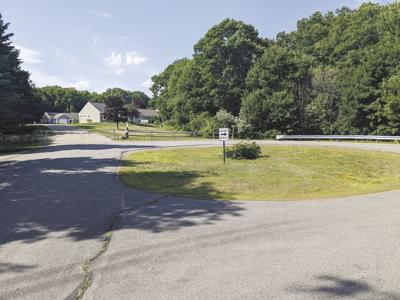LACONIA — The City Council voted unanimously in favor of a petition to lay out a public road on the Cottonwood Avenue cul-de-sac at its June 27 meeting. The petition was filed by Cottonwood resident Nancy Ettelson and is the latest development in a litigious dispute between some Cottonwood residents, the city, and the Taylor Community over whether the cul-de-sac is, or ought to be, a public road.
Per state law, for a municipal legislative body to lay out a public road over a private one, it must find an occasion, or compelling public need, to do so.
At a public hearing on the petition at the June 13 council meeting, Cottonwood residents and petition signatories said they felt the cul-de-sac was essential to the safe and smooth flow of traffic on the dead-end street, especially since traffic volume had increased due to Taylor Community maintenance vehicles.
Legal representation for Taylor argued that the alleged occasion cited by Cottonwood residents constituted a private inconvenience, rather than a public need. Taylor’s written response to the petition also noted that the city had already, on several occasions in the past, indicated that it viewed the Cottonwood cul-de-sac as a road that was, and should remain, private. Finding an occasion now, Taylor argued, would not be credible because it contradicted past city communication to Taylor.
Cottonwood is connected to Taylor Home Drive via a locked gate; this gate is closed to the public, making Cottonwood a no-outlet street. The cul-de-sac has functioned as a turnaround for vehicles since being built and paid for by Taylor in 1987, when it developed property there. A 2019 application by Taylor to change the the cul-de-sac to a hammerhead or T-style turnaround — which, according to Taylor’s response to the petition, was submitted after consultation with city departments to ensure the new turnaround would not make the road less safe or usable — was denied by the Laconia Planning Board.
A superior court ruled in Taylor’s favor that, though Taylor had dedicated the cul-de-sac to public use in 1987, the city had never accepted it and the road remained private. Cottonwood residents subsequently submitted a petition to the city council to lay out a public highway over the cul-de-sac, which would prevent Taylor from redeveloping the end of the road.
The council sided with the Cottonwood residents by granting the petition on June 27.
“First, it is important to note that we are not being asked to decide between the cul-de-sac as it presently exists on the ground and the T or hammerhead proposed by Taylor Community. Nor are we accepting the dedication of the cul-de-sac,” Councilor Henry Lipman stated in his motion to grant the petition. “We have been asked to lay out a public cul-de-sac over the existing private road cul-de-sac. While Taylor Community has granted permission for the city and public to utilize that public road, the permission may be withdrawn for everyone other than Ms. Ettelson at any time.”
Though the cul-de-sac is now a public highway, it remains on land owned by Taylor Community. Taylor can rescind its permission for the public to use the cul-de-sac, except for Ettelson, who is the only property owner besides Taylor with frontage on the road.
The council found occasion to lay out the public road, as stated in Lipman’s motion, as it was already well-integrated into the city road system, would ensure the safe and smooth passage and functionality of emergency, public works, and school transportation vehicles, would be used daily by city residents, and would incur only minor costs to the city through maintenance. The motion did not grant any damages to Taylor, citing its dedication of the road to public use in 1987.
“I was surprised, to be honest,” said Michael Flaherty, president of Taylor Community, in an interview about the outcome. “I felt that the mayor and the city council did not fully comprehend the ramifications of the decision they were making.”
Flaherty said he was concerned that in this decision, and the precedent it sets, the interests of a small group of citizens were chosen over the general interests of the city and of the more than 300 city residents living in the Taylor Community.
“Laconia is no different than the rest of New Hampshire, one of the oldest states in the country. We are meeting the challenge of serving that growing community,” Flaherty said. “But we are landlocked; we don’t have much more room.”
Flaherty said he did not think the public hearing and concerns brought by Cottonwood residents presented an accurate picture of the dynamic on Cottonwood.
“The concerns about traffic were misguided,” Flaherty said. “Our tractors, maintenance vehicles — we are working to improve and maintain the property we bought there, and actually improving the property values for everyone on that street.”
Flaherty continued that he felt the concerns brought by petitioners at the hearing were emotionally fueled. “Things are changing in the neighborhood,” he said, and “that makes them nervous.”
“Taylor Community is, and will continue to be, a good neighbor,” he said.
Ettelson declined to comment on the council’s decision.
In an interview, Mayor Andrew Hosmer said that “the council was very thoughtful in weighing the position of the residents of Cottonwood, the Taylor Community, and considering what the city’s intent was in 1987.”
Taylor’s 1987 site plan for the property at the end of Cottonwood, approved by the city, dedicated the cul-de-sac to public use. The original site plan described that the cul-de-sac would be built by Taylor and conveyed to the city. That conveyance was never executed and the dedication by Taylor of the cul-de-sac was never accepted by the city, but, Hosmer said, “the intent was clear.”
Hosmer said that, though there were occasions where city departments and employees had expressed that they considered the cul-de-sac a private road, and he “could see why a party would rely on that,” and that the city council “does not believe that expressions made by a city employee binds the city.” The council, he feels, is obligated to its 1987 intentions, and this laying out of a public road, though not technically an acceptance into the public road system, is a tying up of that loose end. Laying out is a way of using eminent domain to make a private road public; dedication and acceptance is a different avenue to that end.
Flaherty said that Taylor has not yet determined its next step. “We are keeping all our options open,” Flaherty said.
“We are considering taking this back to superior court, and confident that the judge would make the right legal decision,” Flaherty said. Taylor is also considering different plans for the redevelopment of its property at the end of Cottonwood Avenue, such as pickleball courts or a residential building that would meet the zoning requirements of the cul-de-sac.
The mayor said that, if Taylor were interested in meeting with the city to discuss their future development plans for the area, “the door is open.”


















(0) comments
Welcome to the discussion.
Log In
Keep it Clean. Please avoid obscene, vulgar, lewd, racist or sexually-oriented language.
PLEASE TURN OFF YOUR CAPS LOCK.
Don't Threaten. Threats of harming another person will not be tolerated.
Be Truthful. Don't knowingly lie about anyone or anything.
Be Nice. No racism, sexism or any sort of -ism that is degrading to another person.
Be Proactive. Use the 'Report' link on each comment to let us know of abusive posts.
Share with Us. We'd love to hear eyewitness accounts, the history behind an article.